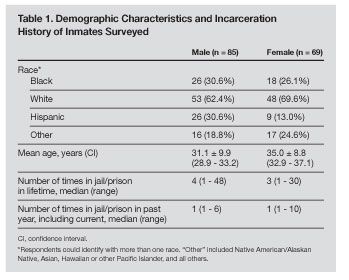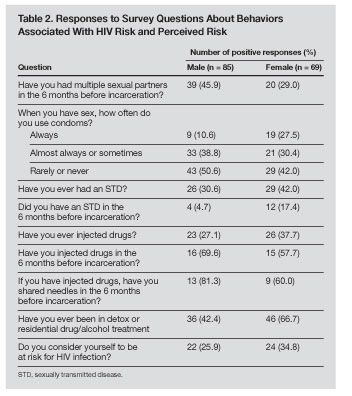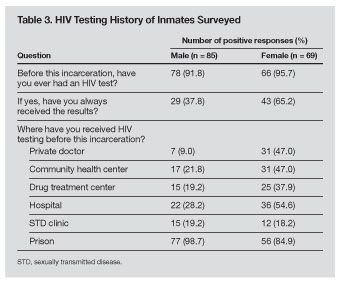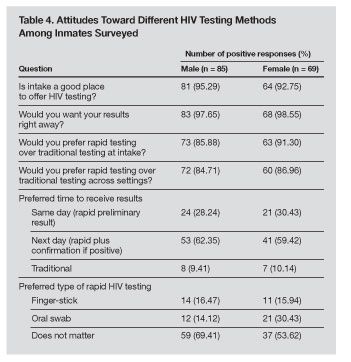- Clinical Technology
- Adult Immunization
- Hepatology
- Pediatric Immunization
- Screening
- Psychiatry
- Allergy
- Women's Health
- Cardiology
- Pediatrics
- Dermatology
- Endocrinology
- Pain Management
- Gastroenterology
- Infectious Disease
- Obesity Medicine
- Rheumatology
- Nephrology
- Neurology
- Pulmonology
HIV Testing Experiences Among Male and Female Inmates in Rhode Island
We conducted a survey of 154 inmates of the Rhode Island Department of Corrections jail regarding HIV risk, HIV testing experiences, and attitudes toward rapid HIV testing in the correctional setting.
In the United States, there are approximately 1 million people living with HIV/AIDS; one quarter of cases remain undiagnosed.1 Correctional institutions in the United States incarcerate a disproportionate number of HIV-infected persons, many of whom lack access to health care in their communities.2-5
It is estimated that up to one fourth of people living with HIV/AIDS in the United States pass through a correctional facility each year.6 The highest prevalence of HIV infection in the United States is among inmates in the Northeast, with 4.6% being HIV-positive in 2002.7 Female inmates are also disproportionately infected with HIV: in the United States, 1.9% of male inmates and 3.0% of female inmates are known to be HIV-positive.7 In Rhode Island, the HIV prevalence is higher, with 2.1% of male inmates and 9.3% of female inmates infected.7 In the revised HIV testing recommendations released by the CDC, HIV testing was recommended in correctional health care settings to diagnose HIV infection among persons at increased risk and link them to HIV care and preventive services.8
The Rhode Island Department of Corrections (RIDOC) has been offering routine HIV testing since 1991 to all persons processed through the intake center, which acts as the central jail for the entire state. HIV testing is voluntary on jail incarceration but is mandatory for persons who are sentenced to prison. HIV testing at incarceration is offered irrespective of the inmate's risk, and accep-tance rates have been reported to be 90%.9 This correctional HIV testing program has identified approximately one third of Rhode Island's HIV-infected population.10
For inmates who receive a diagnosis of HIV infection, HIV counseling and linkage to HIV care within the RIDOC is provided, and referral to HIV care in the community occurs on release. However, with the use of standard enzyme-linked immunoassay (ELISA) and Western blot HIV testing algorithms, providing jailed inmates with their HIV test results has been problematic. The average length of incarceration in the intake center is 17 days,11 meaning a significant proportion of inmates are released to the community before receiving their HIV test results. Point-of-care rapid HIV testing, which is able to produce preliminary positive and final negative HIV test results in approximately 20 minutes, could potentially improve HIV test result delivery in the jail setting.
We conducted a survey among male and female inmates incarcerated at the RIDOC to evaluate HIV testing experiences, HIV risk behavior, and attitudes toward rapid HIV testing.
MATERIALS AND METHODS
Male inmates incarcerated at the RIDOC jail and female inmates incarcerated in the women's facility, which houses both jail inmates and those sentenced to a prison term, were eligible for the study. Participation was voluntary. Participants had to be English-speaking, and their HIV status was not assessed at study entry. Male inmates were randomly selected from the jail administrative rosters for participation. Female inmates were recruited from a common room within the female facility. Female inmates were informed of the study and could enroll by approaching the study interviewer. The male and female participants were recruited as consecutive samples. The recruitment techniques differed based on the feasibility of recruiting inmates within each correctional facility.
A quantitative survey evaluating demographics, incarceration history, pre-incarceration HIV risk factors, HIV testing history, and attitudes toward rapid HIV testing in jail was administered to the inmates by an interviewer in a private room. Survey responses were summarized according to sex.
The study was approved by The Miriam Hospital Institutional Review Board, which included a prisoner representative, and the Medical Research Advisory Group at the RIDOC. Informed consent was obtained from all participants.
RESULTS
A total of 154 HIV-negative inmates-85 men and 69 women-participated in the study and completed the survey.
Demographics and Incarceration History
Demographic characteristics were similar across the male and female groups (Table 1). Most participants, regardless of sex, had multiple incarcerations. The median number of lifetime incarcerations for men was 4 (range, 1 to 48) and for women, 3 (range, 1 to 30).

HIV Risk Assessment
There was low self-perceived HIV risk among both male and female participants as compared with self-reported high-risk behaviors. Twenty-six percent of the men and 35% of the women considered themselves to be at risk for HIV infection (Table 2).

In contrast to self-perceived HIV risk, the median number of lifetime sexual partners was 15 (range, 1 to 200) for men and 9 (range, 2 to 400) for women as self-reported in this study. Nearly 46% of men and 29% of women had multiple sexual partners in the 6 months before incarceration. Rates of consistent condom use with sex were low among both men and women, with 10.6% of men and 27.5% of women reporting that they always used a condom. Nearly 51% of men and 42% of women reported rarely or never using a condom with sex. About 31% of men and 42% of women reported ever having a sexually transmitted disease (STD), but women were more likely than men to have had an STD in the 6 months before incarceration (17.4% and 4.7%, respectively).
Injection drug use was prevalent among both male and female inmates. Within this study population, 27.1% of men (23 of 85) and 37.7% of women (26 of 69) had ever injected drugs. Of these, 16 men and 15 women were active users (ie, had injected drugs in the 6 months before incarceration). Needle sharing was common among active users, with the majority of men and women who had injected drugs in the 6 months before incarceration sharing needles during that time. Overall, 36 of the 85 men and 46 of the 69 women had been in a detoxification program or received other residential drug/alcohol treatment before study entry.
HIV Testing History
A large proportion of both men and women had completed HIV testing in the past. Before this incarceration, 93.5% of the 154 participants reported having at least 1 HIV test, and the correctional setting was the most common site of HIV testing regardless of sex. Of those who had been tested previously, 31 (40%) of 78 men and 7 (11%) of 66 women had only been tested in the correctional setting. With respect to HIV test result receipt, only 37.8% of men and 65.2% of women stated they had always received their HIV test results following testing in any setting. For persons who had been tested in the community (at doctors' offices, community health centers, drug treatment centers, or hospitals), women were more likely than men to have received their test results (Table 3).

Attitudes Toward Rapid HIV Testing
Rapid HIV testing was acceptable to both male and female inmates. Nearly all participants agreed that the correctional setting was a good place to offer HIV testing. Ninety-eight percent (151 of 154) agreed that if possible, they would like their HIV tests results right away as opposed to several weeks later. When given the choice between traditional methods of HIV testing (standard ELISA followed by a Western blot test for confirmation) and rapid testing, which would require positive results to be confirmed by Western blot test, 88% responded that they would prefer rapid HIV testing. Both male and female inmates indicated that they would prefer rapid over traditional methods of HIV testing outside the correctional setting as well.
Inmates were also asked to choose which of the following scenarios they preferred with regard to receipt of test results: (1) immediate receipt of a rapid test result, knowing that a confirmatory test would still need to be performed in the event of a positive rapid test result; (2) next-day receipt of rapid test result, including the result of a confirmatory test (in the event of a positive rapid test result); or (3) traditional HIV test results, which are typically available in 10 to 14 days. Among both men and women, the majority of inmates preferred scenario 2, in which rapid HIV test results and confirmatory test results would be available the day after testing (Table 4).

DISCUSSION
HIV risk was high among both men and women in this incarcerated population. Many of the participants engaged in sex with multiple partners, rates of condom use were low, and almost one third reported a history of injection drug use. One in 5 was an active injection drug user, and the majority of active injectors admitted to sharing needles. Despite reporting substantial pre-incarceration HIV risk behavior, only one quarter of men and one third of women considered themselves at risk for HIV infection. Incarcerated persons exhibited an incomplete appreciation of their HIV risk behavior. Low perceived HIV risk contributes to low testing rates among at-risk persons.12 These findings support the implementation of HIV education, prevention interventions, and HIV testing programs in the incarceration setting.
Survey responses indicated that current HIV testing procedures are inadequate. HIV test result receipt was poor in general, and test results had not been effectively delivered in the correctional setting. Test result delivery is particularly problematic in jails, where incarcerations are typically brief. Standard HIV testing algorithms that use an ELISA screening test followed by a Western blot confirmatory test may require up to 2 weeks for test results to become available. A significant proportion of jail detainees are released before this time, missing the opportunity to receive results and posttest HIV counseling.
In this study, a significant proportion of men and women had only been tested in the correctional setting. This highlights the fact that inmates often are a marginalized group with less access to health care resources in their communities; thus HIV testing might not be accessed if it is not offered in the correctional setting. Women describe greater utilization of community HIV testing services, perhaps because of increased contact with the health care system for obstetrical and gynecological care.
As demonstrated in this study, women are more likely than men to receive HIV test results from community testing sites but overall are more likely to get tested in the correctional setting. This may be a local phenomenon, given the fact the RIDOC has been testing the majority of incarcerated persons for over 15 years. This may not be the case in most other states. The benefits of this well-established testing program are numerous and include identification of a large proportion of HIV-infected persons within the state, delivery of HIV care and secondary preventive services (including partner notification), and linkage to HIV care in the community. This program may have contributed to the substantial decline in new HIV diagnoses related to injection drug use in the state over the past decade.13
According to this survey, rapid HIV testing appears to be highly acceptable in the incarceration setting and preferable to traditional testing methods for both male and female inmates. The majority of inmates would prefer to receive their test results the next day after confirmatory testing was completed (in the event of a positive rapid test) rather than receiving same-day preliminary results or waiting for traditional test results. This preference may be related to the inmates' concern about being told that they have a positive rapid HIV test result at the same time they are being incarcerated, which could be emotionally overwhelming to them.
Further research is needed to elucidate these issues and to determine how to best incorporate rapid HIV testing into the delivery of health care in the correctional setting. Furthermore, there is a need to develop new rapid confirmatory testing assays that would allow point-of-care confirmation, thus expediting the delivery of confirmed positive HIV test results. The use of sequential rapid HIV tests of different manufacturers may be an option, but further research is needed to determine whether this approach would be specific enough to obviate a Western blot assay. Point-of-care nucleic acid testing may also be an option for confirmatory testing and is an active area of research.
There were limitations to this study. First, different recruitment methods were used for male and female inmates. This was a function of feasibility given the individual characteristics of each facility. These different recruitment methods created male and female cohorts that differed in total number of participants and length of incarceration (the men were jail inmates and the women were a mixture of jail and prison inmates). These differences eliminated the possibility of comparisons between the male and female cohorts. We were also limited in our ability to assess response rates, since data on the eligible population for study participation was not collected.
The correctional setting is an ideal venue in which to offer HIV testing, since it provides access to persons at increased risk for HIV infection who are often disenfranchised from health care resources in their community. However, HIV testing programs in the correctional setting must ensure confidentiality of test results and accessibility of HIV care for persons identified as HIV-infected.
Rapid HIV testing addresses 1 of many barriers to effective testing in corrections: the delivery of results. Timely delivery of results is beneficial, since it provides an opportunity to complete risk reduction counseling for persons identified as either HIV-negative or -positive. Persons who are identified as HIV-positive can be linked to HIV care both in the correctional setting and after release, when care can be transferred to community-based providers. The results of this study support further investigation into the implementation of rapid HIV testing programs in correctional settings.
Acknowledgments: This research was facilitated by the infrastructure and resources provided by the Lifespan/Tufts/Brown Center for AIDS Research, an NIH-funded program (#P30AI42853). For this study, Drs Beckwith, Cohen, and Lally received grant support from the NIH (Grants 1K23DA021095-01A2, 5T32DA013911-04, and 1K23DA004604-01AI, respectively). The authors wish to acknowledge the clinical staff and correctional officers of the Intake Service Center at the Rhode Island Department of Corrections.
No potential conflict of interest relevant to this article was reported by the authors.
References:
References1. Glynn M, Rhodes P. Estimated HIV prevalence in the United States at the end of 2003. National HIV Prevention Conference; June 12-15, 2005; Atlanta. Abstract 595.
2. Braithwaite RL, Arriola KR. Male prisoners and HIV prevention: a call for action ignored. Am J Public Health. 2003;93:759-763.
3. Conklin T, Lincoln T, Tuthill R. Self-reported health and prior health behaviors of newly admitted correctional inmates. Am J Public Health. 2000;90:1939-1941.
4. Glaser J. Sexually transmitted diseases in the incarcerated. An underexploited public health opportunity. Sex Trans Dis. 1998;25:308-309.
5. Sylla M, Thomas D. The rules: law and AIDS in corrections. HEPP News. 2000;3:1. Available at: http://www.aegis.com/pubs/hepp/2000/HEPP2000-1101.html.
6. Hammett TM, Harmon MP, Rhodes W. The burden of infectious disease among inmates of and releasees from US correctional facilities, 1997. Am J PublicHealth. 2002;92:1789-1794.
7. Maruschak LM. HIV in prisons and jails, 2002. Bureau of Justice Statistics Bulletin, US Department of Justice, Office of Justice Programs. NCJ. 2004;205333:1-11.
8. Centers for Disease Control and Prevention. Revised recommendations for HIV testing of adults, adolescents, and pregnantalth-care women in he settings. MMWR. 2006;55:1-17. Available at: http://www.cdc.gov/mmwr/preview/mmwrhtml/rr5514a1.htm. Accessed July 26, 2007.
9. Flanigan TP. HIV testing in prison. Lancet. 1995;345:390.
10. Desai AA, Latta ET, Spaulding A, et al. The importance of routine HIV testing in the incarcerated population: the Rhode Island experience. AIDS Educ Prev. 2002;14(5 suppl B):45-52.
11. State of Rhode Island and Providence Plantations Department of Corrections. Available at: www.doc.ri.gov/index.php. Accessed July 26, 2007.
12. Couturier E, Schwoebel V, Michon C, et al. Determinants of delayed diagnosis of HIV infection in France, 1993-1995. AIDS. 1998;12:795-800.
13. Beckwith CG, Moreira CC, Aboshady HM, et al. A success story: HIV prevention for injection drug users in Rhode Island. Subst Abuse Treat Prev Policy. 2006;1:34.
